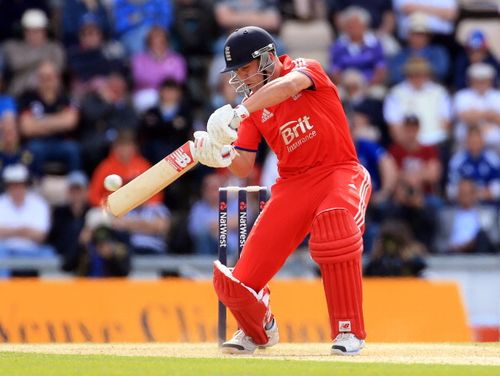
Of Depression and Cricketers - The dark side of cricket

Jonathan Trott – Neither England nor the world cricket is rich enough to lose such a quality player, but depression had the final verdict
Earlier this week, John Mooney, one of Ireland’s key players in recent years, returned home from his country’s tour of West Indies with a stress related illness. That’s the second such major incident in world cricket of late. The first being Jonathan Trott who called it quits from the Ashes 2013-14 after the first Test. And there have been many a documented cases of depression over the past decade, starting from Trescothick’s withdrawal from the Ashes tour of 2006.
Research studies suggest that one in six grown up males will suffer from a bout of depression at some stage of their life. In line with this study, experts suggest that 15% of elite sportspersons suffer from depression, which means that 2 people in every dressing room could potentially be suffering from some form of mental illness. Though it is good that few people have started coming out of the closet, it is scary to imagine how many cricketers might be hiding the problem out of peer pressure.
Cricket, in all probability, is the most mentally challenging team sport of all. Other team sports are usually a 2-hour affair at the maximum and allow the athletes enough time to recuperate during the day. Cricket is different, Test cricket in specific. Batsmen are expected to cement themselves on the pitch for hours – a day or day and a half – to score big runs for the team. This requires them to maintain high levels of concentration, thereby draining them mentally and sapping them physically.
The factors that could play in a batsman’s mind at any given instant he is readying himself to face a ball can include a play and miss, his wicket in the previous innings, his own form, a rough patch on the pitch, overcast conditions, seeing his fellow batsman fall to an absolute peach, etc. The bowlers have an equally taxing challenge. A bowler needs to – run in for long periods, try various tricks and techniques, try to fox the batsmen, try something different – only to see the batsman leave all the 6 balls in an over. Failing to get a wicket after the long haul, also, gives way to self doubts for the bowler such as “Am I good enough to get his wicket, and if so, Why haven’t I dismissed him yet?”.
And then, we have the fielders. Though it seems like an easy job to stand in a position for long hours or chase the ball when hit in their direction and throw it back, it isn’t. It is easy to switch off knowing that the ball would probably come along their path only a few times during the hours of play. But, no, they need to be sharp throughout the day, follow the ball from the bowler’s hand right upto the batsman’s bat, and react instantly. And the sitter he dropped is usually remembered than the stunner he picked. Not an easy life.
Then there is the constant public attention, innumerable media houses attempting to track every single movement of the cricketers, the plethora of cameras capturing their mistakes, fans swaying from hero worship to fanatical cynics, etc. Cricketers are often required to commit to long away tours, keeping them away from family and friends for months. Being involved in high pressure International tussles and in a foreign environment, away from their confidantes, does take its toll on the athletes.
Cricket is one sport in which an athlete has more elements out of his control, than in his control – the weather, the pitch, the bowler’s form, a fielder taking a stunner or dropping a sitter, the opposition’s scorecard, your team’s score, the next batsman coming in, the umpire having a bad day, etc. Taking all the above mentioned points into account, it is a marvel that there haven’t been more cases of depression in the sport. The only documented higher profile cases of depression are Trescothick, Michael Yardy, Ian O’Brien and Trott.
Sportsmen are not naturally emotional folks, says Ian Maynard, a professor of Sports psychology at Sheffield Hallam University. To quote him “They don’t wear their heart on their sleeve because that can cause problems in competition, so they tend to be more buttoned-up and get a mentally tough exterior”.
Ian O’Brien, who was open about his bouts of depressions, has talked about the various antics of players with whom he has shared the dressing rooms. He claims he has played with cricketers with weird OCD tendencies and adds that a few even had symptoms of Asperger’s syndrome. He says most players tend to think of their next set of failures, and not on their next success. Such negative thinking incites episodes of depression in them.
David Firth, the founding editor of Wisden Cricket Monthly, wrote a book on depression and suicides in cricket (Silence of the Heart: Cricket Suicides). His central idea revolves around the point that cricket as a sport advocates thought patterns and anxiety that careens athletes into the limbo of depression. This suggests that the lesser number of documented cases of depression in cricket is a case of cricketers not coming out of the closet, and not them being immune to it.
Cricket will continue to be a mentally exhausting sport. No change in rules, formats, ball colours, time of play, etc., will help the cricketers in escaping these spells of mental pressures. There is a major need for research to be done in the field of depression in cricket so that there is an increase in awareness and literacy among cricketers across all levels, and not just international. There should be regular training and rehabilitation programs for cricketers who face the rigours of International cricket. The topic of depression shouldn’t be taboo; the more one talks about it, the better it is for the athletes.